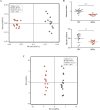The gut microbial metabolic capacity of microbiome-humanized vs. wild type rodents reveals a likely dual role of intestinal bacteria in hepato-intestinal schistosomiasis
- PMID: 36279280
- PMCID: PMC9633004
- DOI: 10.1371/journal.pntd.0010878
The gut microbial metabolic capacity of microbiome-humanized vs. wild type rodents reveals a likely dual role of intestinal bacteria in hepato-intestinal schistosomiasis
Abstract
Increasing evidence shows that the host gut microbiota might be involved in the immunological cascade that culminates with the formation of tissue granulomas underlying the pathophysiology of hepato-intestinal schistosomiasis. In this study, we investigated the impact of Schistosoma mansoni infection on the gut microbial composition and functional potential of both wild type and microbiome-humanized mice. In spite of substantial differences in microbiome composition at baseline, selected pathways were consistently affected by parasite infection. The gut microbiomes of infected mice of both lines displayed, amongst other features, enhanced capacity for tryptophan and butyrate production, which might be linked to the activation of mechanisms aimed to prevent excessive injuries caused by migrating parasite eggs. Complementing data from previous studies, our findings suggest that the host gut microbiome might play a dual role in the pathophysiology of schistosomiasis, where intestinal bacteria may contribute to egg-associated pathology while, in turn, protect the host from uncontrolled tissue damage.
Conflict of interest statement
The authors declare that they have no competing interests
Figures




References
-
- McManus DP, Dunne DW, Sacko M, Utzinger J, Vennervald BJ, Zhou X-N. Schistosomiasis. Nat Rev Dis Primer 2018; 4: 13. - PubMed
Publication types
MeSH terms
Grants and funding
LinkOut - more resources
Full Text Sources

